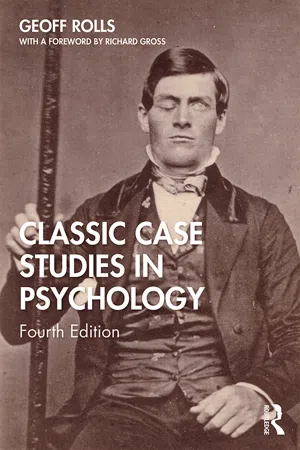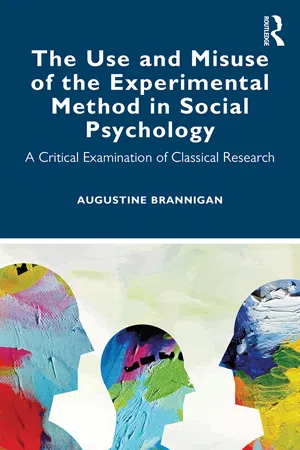Psychology
BBC Prison Study
The BBC Prison Study was a social psychology experiment conducted in 2002, inspired by the Stanford Prison Experiment. It aimed to investigate the psychological effects of perceived power and authority in a simulated prison environment. The study highlighted the potential for individuals to conform to social roles and the ethical considerations of conducting research in such settings.
Written by Perlego with AI-assistance
Related key terms
3 Key excerpts on "BBC Prison Study"
- eBook - ePub
Police Ethics
The Corruption of Noble Cause
- Michael A. Caldero, Jeffrey D. Dailey, Brian L. Withrow(Authors)
- 2018(Publication Date)
- Routledge(Publisher)
The leadership of both the guard and prisoner groups emerged internally, as the groups adapted to the role expectations they thought were appropriate. One can see that one of the graduate students in charge of the guard group tended to “go native.” This shift likely affected the experiment in unpredictable ways. Gordon asked me a very simple question: “Say, what’s the independent variable in this study?” To my surprise, I got really angry at him. Here I had a prison break on my hands. The security of my men and the stability of my prison were at stake, and now, I had to deal with this bleeding-heart, liberal, academic, effete dingdong who was concerned about the independent variable! It wasn’t until much later that I realized how far into my prison role I was at that point—that I was thinking like a prison superintendent rather than a research psychologist. (Zimbardo, 2008: 127) This graduate student was acting, not like a prison warden as he states in the quote in Zimbardo (2008), but like he thought a prison warden would act. That is part of the central issue here. They are taking on roles—including the staff—when they do not actually know how to do them. Mike: Let me talk about another experiment, one that gives us something to work with. It is called the British Broadcasting Company Prison experiment. It tells us about the importance of leadership in stressful prison settings. In a British Broadcasting Company (BBC) Prison Study intended as a follow-up to the Stanford Prison Experiment, Haslam and Reicher revisited the Stanford experiment and came to different findings (see Reicher and Haslam, 2006). Group culture and leadership, they found, affected the tendencies of groups to become more authoritarian. When stress increases on group members, the result can be increasing support for authoritarian leadership - eBook - ePub
Classic Case Studies in Psychology
Fourth Edition
- Geoff Rolls(Author)
- 2019(Publication Date)
- Routledge(Publisher)
1 and his colleagues (Haney et al., 1973) began a study that drew on the previous ‘obedience’ research by Stanley Milgram (1963). The Stanford Prison Experiment (SPE) as it is now known would become almost as well known a social psychology study as Milgram’s did ten years previously. The research would question the nature of ‘evil’. Was evil behaviour due to a person’s personality or was it dependent on the situation or particular circumstances that someone faced? The basic premise was to test the ‘dispositional’ hypothesis, that the conditions experienced within prisons come about as a result of the ‘nature’ and personality of the people who populate it, be they guards or prisoners. It follows that it is these people’s personalities rather than the conditions in the prison that affect their behaviour. If it is the personality that is imported into the prison that affects behaviour then changing the conditions in the prison will not affect behaviour, whereas if there is a situational influence then changing conditions in the prison would have some positive effects. To test this ‘dispositional’ versus ‘situational’ hypothesis it would need a new prison to be set up comparable to existing prisons, but with inmates and guards who were ‘normal’ or average members of the population without any anti-social tendencies. The study’s findings would have socially sensitive consequences for all of us and lead us to question how we might act in a given situation. Interestingly, many of the research conclusions drawn by Zimbardo have been questioned and the actual findings have not been replicated but despite this, it’s true to say that the research remains a seminal study in social psychology and continues to influence both psychological and legal argument to this day.On 14 August 1971, 24 male college students at Stanford University were recruited to take part in a simulated prison study in the basement at the university. These students were chosen specifically because they had been assessed as being well-adjusted individuals without any deviant or aggressive tendencies. The student volunteers were randomly assigned to the role of either a ‘guard’ or ‘prisoner’ with 12 students in each group. The mock prison was set up with Philip Zimbardo himself acting as the prison superintendent. The participants were told that the aim of the study was to investigate the psychological effects of being a prisoner or prison guard and to see how the power of roles, deindividuation, depersonalisation and disorientation could affect the volunteers. - eBook - ePub
The Use and Misuse of the Experimental Method in Social Psychology
A Critical Examination of Classical Research
- Augustine Brannigan(Author)
- 2020(Publication Date)
- Routledge(Publisher)
4 Scientific demonstration in Milgram, Zimbardo, and RosenhanMore evidence from the archivesIntroduction
In this chapter, we focus on three of the most provocative studies in classical social psychology: Stanley Milgram’s obedience study, Philip Zimbardo’s Stanford Prison Experiment, and David Rosenhan’s study of psychiatric hospitals. The theme that unites these diverse investigations is the utilization of the experiment as a pedagogical device to demonstrate a perspective whose findings are a foregone conclusion.The Holocaust and obedience to authority
Although Milgram’s study was derived conceptually from the work of Solomon Asch (Sabini 1986), the trial of Adolph Eichmann sharpened the issues for him. Eichmann was the allegedly plodding Nazi bureaucrat who assisted in the mass murder of European Jewry by masterminding the concentration of the victims in Poland after the Nazi occupation of France and most of western Europe. Subsequently, the Nazis developed factories for the extermination of Jewish victims at Treblinka, Sorbibor, Auschwitz, and other death camps. Several million innocent people, men, women, and children, were murdered at these death camps by ordinary German administrators, policemen, soldiers, and camp guards. In Milgram’s experiment, ordinary subjects were cast in the parts of executioners. In the “received view” of this work (Stam, Radtke, and Lubek 1998), Milgram took people from all walks of life and turned them into the experimental analogs of Eichmann, suggesting that the capacity for evil was fostered in virtuous individuals by monstrous bureaucrats. The existential problem could not have been more clear-cut. Indeed, all of Milgram’s work has the bite of immediate relevance.The study was advertised as an experiment designed to test the effects of punishment on human learning. Subjects (“teachers”) were paid to teach the “learners” to memorize a long series of paired associations. The pretext for the study was to advance knowledge about the effectiveness of negative reinforcements on learning. Errors were to result in a shock, but the level of the shock escalated at every mistake in fifteen-point gradations from 15 volts right up to and beyond 450 volts. The experiment was run with individual teachers and learners, but the role assignment was rigged so that the real subject was always assigned the role of the teacher who administered shocks, while an affable middle-aged man, a confederate, acted as the learner. The teachers were given a sample shock to demonstrate the actual discomfort that resulted from their control of the shock machine. The machine was an impressive electrical appliance with switches, lights, and verbal designations describing the severity of the shock (mild, moderate, high, extremely high, XXX). The subjects were drawn from a wide range of occupations and professions, unlike the usual captive population of undergraduate students.
Learn about this page
Index pages curate the most relevant extracts from our library of academic textbooks. They’ve been created using an in-house natural language model (NLM), each adding context and meaning to key research topics.


